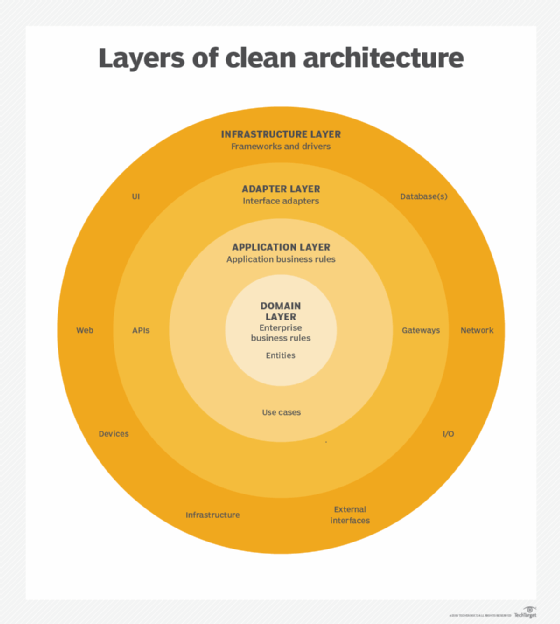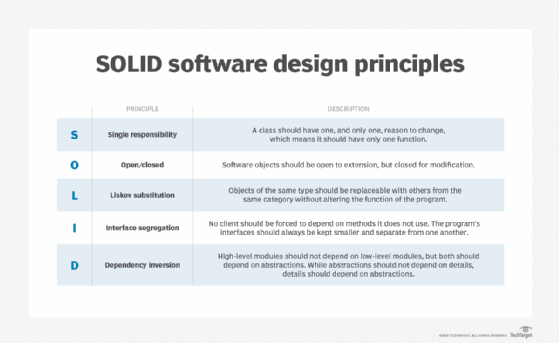
Fotolia
A primer on the clean architecture pattern and its principles
Stability is a crucial aspect of application architecture. Learn how clean architecture can straighten out your dependencies and make an app that is built to last.
Over the past several years, the software development community has seen several innovative architectural styles emerge, including microservices and serverless. Each one has its own unique traits, behaviors, technical structure and required expertise. But, overall, they all represent a part of the universal demand for a greater separation of architecture concerns and improved testability.
Clean architecture is yet another one of these architectural styles, though it might be more accurately described as a set of guidelines. Proposed and evangelized by Robert C. Martin, it acts a blueprint for modular systems that strictly adhere to the separation of concerns design principle. The goal of clean architecture is to create layered architectures that are simple, extendable and easy to maintain.
Let's take a closer look at the clean architecture pattern and its principles.
4 layers of clean architecture
When working with clean architecture, the dependencies in an application are designed for stability. This means that less-stable components should only depend on components that are more stable. The clean architecture pattern also dictates that the more stable a component is, the more abstract component types it should contain. In the end, code that follows this pattern is decoupled, reusable and easier to maintain.
The clean architecture pattern dictates a separation of software elements, visualized as a layered ring.

1. The domain layer
The center of the ring, the domain layer, houses the overarching business rules, logic and needs that form the foundation for the application's intended role and purpose. This core also contains what are known as "entities," which represent the class and interface types needed by the enterprise business rules. These types encapsulate the most general and high-level rules that the application would take advantage of. These types do not have any knowledge of the other layers nor do they have any dependency on any other types of components residing in the outer layers.
2. The application layer
The application layer, which sits outside of this core, contains the rules and logic that relate specifically to the application's design and behavior. This layer includes "use cases" which refer to the specific business rules that define the application's responsibilities and expected behavior. It is isolated from external elements, such as the user interface, database and frameworks, to maintain the intended separation of concerns.
3. Adapter layer
The next layer holds APIs and gateways, which govern the flow of communication between the application's back end and the external components. This layer is responsible for outward facing elements such as the application presenters, views and controllers. In clean architecture, none of these external components should have any knowledge of or dependence on the data persisted in the database.
4. Infrastructure layer
Finally, the outermost infrastructure layer serves up all necessary details pertaining to the particular web frameworks or database models in use. These details should be abstracted from the domain layer, since teams will need to alter the configuration of these frameworks and databases over time. By abstracting these details, teams can update and modify an application's code structure, data models and user interface without impacting the foundational domain layer.
5 steps to clean architecture
To get started implementing clean architecture, follow the points given below:
- Split your application's code into layers.
- Place abstractions in the inner layers.
- Put implementation in the outer layers.
- Point dependencies inwards.
- Follow test-driven development outside-in.
The 8 principles of clean architecture
Clean architecture demands a set of eight specific application design principles and development rules.
Dependency rule
The essence of the dependency rule rests in controlling the flow of application dependencies. While any one of the layers in a clean architecture can encapsulate a dependency, those dependencies can only point inward, as the inner layers are designed not to have any knowledge of the outer layers. For example, while the adapter layer can retain a dependency with an application layer component, the application layer cannot be dependent on anything within the adapter layer.
Abstraction principle
The abstraction principle states that the business rules and application layers should contain business rules/business logic, with the innermost circle being the most abstract. Meanwhile, the adapter and infrastructure layers should contain implementation details, with the outermost circle being the most concrete.
SOLID
SOLID refers to a list of five object-oriented design rules teams must follow to create a simple, extendable, flexible and maintainable software architecture. These rules are commonly known as the SOLID principles.

Reuse/release equivalence principle (REP)
REP states that a release should never contain collections of unrelated classes. Instead, any class or module released should be reusable as a cohesive unit and tracked through a well-defined release process.
Common closure principle (CCP)
CCP demands that application components should contain collections of shared classes, and that the classes in each collection should always change at the same time for the same reason. The term "common closure" implies that classes that change for the same reason should exist in a closed set.
Common reuse principle (CRP)
This principle states that the classes in a component should be reused together -- if you reuse one of them, you reuse them all. This is similar to the interface segregation principle found in SOLID, in that it prevents classes from containing methods it doesn't use.
Acyclic dependency principle (ADP)
If multiple components have a feedback loop of dependencies, you have what is known as a dependency cycle. It is difficult to make changes when this is the case, so ADP dictates that there should not be any dependency cycles in an application. The solution to breaking these cycles is using dependency injection.
Ports and adapters
Ports are the interfaces exposed by the application, while adapters slot those interfaces. While ports are independent of any technology, adapters are technology-specific, allowing them to manage the specific adjustments needed for a particular type of component. Clean architecture takes advantage of the ports and adapters pattern, also known as the hexagonal architecture pattern, to implement a separation of concerns, as neither the application nor the port need understand the technology-specific details handled by the adapter.








